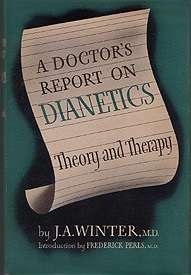A Doctor's Report on Dianetics
 Cover of the first edition | |
| Author | Joseph A. Winter |
|---|---|
| Country | United States |
| Language | English |
| Subject | Dianetics |
| Publisher |
Julian Messner Crown Publishing Group |
Publication date | 1951, 1987 |
| Media type | Print (Hardcover) |
| ISBN | 0-517-56421-1 |
A Doctor's Report on Dianetics: Theory and Therapy is a non-fiction book analyzing Dianetics. The book was authored by physician Joseph Winter, with an introduction by German psychiatrist Frederick Perls.
The book was first published in hardcover by Julian Messner, in 1951, and published again in 1987, by Crown Publishing Group. The work was the first book published that was critical of L. Ron Hubbard.[1]
About the author
Joseph Augustus Winter, a medical doctor and "psychosomatacist",[2] had previously served on the board of directors and as the medical director of L. Ron Hubbard's Dianetic Research Foundation. He also wrote the introduction to Hubbard's Dianetics: The Modern Science of Mental Health.[3] Winter resigned from the foundation in October 1950, stating "there was a difference between the ideals inherent within the dianetics hypothesis and the actions of the Foundation".[1][2] He also felt that Dianetic techniques were potentially dangerous if performed without medical training and disapproved of the lack of scientific evidence supporting Hubbard's claims.[1] Prior to their falling out, Winter had stated that the Dianetic technique of auditing had cured his six-year-old son of fears of ghosts and the dark.[2]
Main points
According to a 1951 article in Time magazine, in A Doctor's Report on Dianetics "Winter tries to filter Hubbard's strange mixture and pick out the scraps fit for human consumption".[2] Winter wrote that auditing could be a useful technique for psychiatrists to use during psychoanalysis and agreed with Hubbard's conceptualization of prenatal "engrams", that traumatic memories can be formed and stored during the prenatal stage, but Winter was skeptical about "sperm dreams", stating they were likely imagined and not true memories.[4]
Winter also objected to patients recalling deaths from previous reincarnations, Hubbard's authoritarian attitude and disregard for using the scientific method, and Hubbard's view that anyone could become an auditor without medical training.[1][2][4][5] Winter wrote that Hubbard's techniques sometimes harmed clients,[6] and that he had yet to observe a single "Clear" (Hubbard's term for people with an allegedly "optimum brain" after being cleared of all engrams).[1][6][7] Though Hubbard claimed that a Clear had been obtained after twenty-four hours of therapy, Winter wrote that he never observed an individual reach the state of Clear or display any of the unique abilities Hubbard attributed to a Clear.[7] Winter also believed that some people became psychotic due to their involvement with Dianetics, and he included a case study in the book.[3]
Winter also rebuked Hubbard's "Guk" program, which was a combination of vitamins and glutamic acid that was meant to make Dianetics subjects "run better".[1][2][8]
Critical reception
The Princeton Theological Seminary called it an important new book on psychotherapy, in Pastoral Psychology.[9]
Martin Gardner analyzes the book extensively in Fads and Fallacies in the Name of Science.[4] Gardner wrote that the "most revealing" material in A Doctor's Report on Dianetics, were the records of the author's own auditing sessions.[4] Pitirim Sorokin wrote in The Ways and Power of Love that though Winter wrote an enthusiastic introduction to Hubbard's Dianetics, his own book exposed some of Hubbard's more "charlatanish" claims.[6]
The book was also reviewed in The American Journal of Psychology[8] and The American Journal of Psychiatry.[10] In a review of the book in Psychosomatic Medicine,[11] Frank Egloff wrote that Winter did a "relatively good, factual job" and provided a "fairly clear, dispassionate view of dianetics".[11]
The book is referenced in Rodney Stark's The Future of Religion,[12] and in Frank Gerbode's Beyond Psychology.[13]
References
- 1 2 3 4 5 6 Atack, Jon (August 19, 1990). A Piece of Blue Sky (PDF). Carol Publishing Group. pp. Chapter 2. ISBN 0-8184-0499-X.
- 1 2 3 4 5 6 Staff (September 3, 1951). "Departure in Dianetics". Time Magazine. Time Warner.
- 1 2 Cooper, Paulette (1971). The Scandal of Scientology. Tower Publications. pp. Chapter 1.
- 1 2 3 4 Gardner, Martin (1957). Fads and Fallacies in the Name of Science (PDF). Courier Dover Publications. pp. 274, 275. ISBN 0-486-20394-8.
- ↑ Staff (November 22, 1951). "A Doctor's Report on Dianetics". The Fredericksburg News.
- 1 2 3 Sorokin, Pitirim; Stephen Garrard Post (2002). The Ways and Power of Love: Types, Factors, and Techniques of Moral Transformation. Templeton Foundation Press. p. 508. ISBN 1-890151-86-6.
- 1 2 Bainbridge, William Sims; Rodney Stark (1980). "Scientology: To Be Perfectly Clear" (PDF). Sociological Analysis. doi:10.2307/3709904. Archived from the original (PDF) on 2007-09-28.
- 1 2 Marcuse, F. L.; Winter, J. A. (January 1952). "A Doctor's Report on Dianetics by J. A. Winter". The American Journal of Psychology. University of Illinois Press. 65 (1): 154–155. JSTOR 1418860. doi:10.2307/1418860.
- ↑ Princeton Theological Seminary (1950). Pastoral Psychology. pp. 6, 7. ISSN 0031-2789.
- ↑ Peck, Robert E. (July 1952). "A Doctor's Report on Dianetics". The American Journal of Psychiatry. 109: 70–71. doi:10.1176/appi.ajp.109.1.70-b.
- 1 2 Egloff, Frank R. L. "A Doctor's Report on Dianetics - Theory and Therapy" (PDF). Psychosomatic Medicine. 15 (4): 370.
- ↑ Stark, Rodney; William Sims Bainbridge (January 16, 1986). The Future of Religion. University of California Press. ISBN 978-0-520-05731-9.
- ↑ Gerbode, Frank A. (August 1995). Beyond Psychology: An Introduction to Metapsychology, 3rd Edition. Institute for Research in Metapsychology. ISBN 1-887927-00-X , ISBN 978-1-887927-00-0.
External links
- Reviews
- The American Journal of Psychology, January 1952
- The American Journal of Psychiatry, July 1952